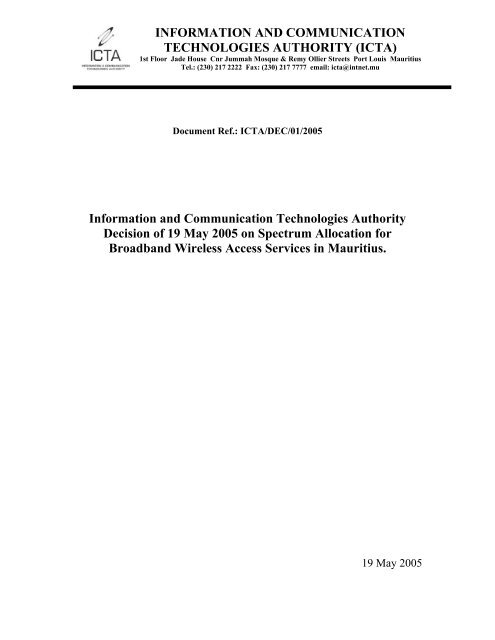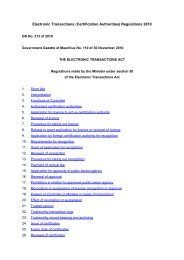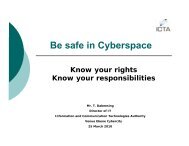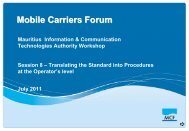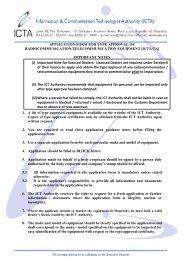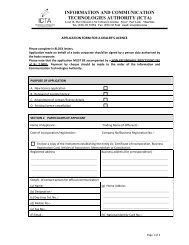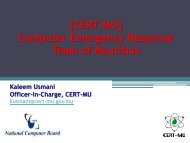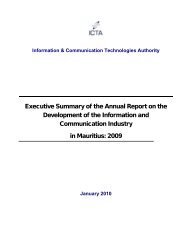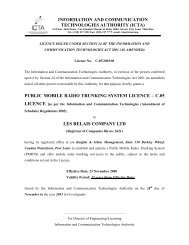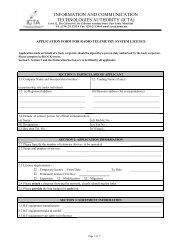Decision of 19 May 2005 on Spectrum Allocation for ... - ICTA
Decision of 19 May 2005 on Spectrum Allocation for ... - ICTA
Decision of 19 May 2005 on Spectrum Allocation for ... - ICTA
You also want an ePaper? Increase the reach of your titles
YUMPU automatically turns print PDFs into web optimized ePapers that Google loves.
INFORMATION AND COMMUNICATION<br />
TECHNOLOGIES AUTHORITY (<strong>ICTA</strong>)<br />
1st Floor Jade House Cnr Jummah Mosque & Remy Ollier Streets Port Louis Mauritius<br />
Tel.: (230) 217 2222 Fax: (230) 217 7777 email: icta@intnet.mu<br />
Document Ref.: <strong>ICTA</strong>/DEC/01/<str<strong>on</strong>g>2005</str<strong>on</strong>g><br />
In<strong>for</strong>mati<strong>on</strong> and Communicati<strong>on</strong> Technologies Authority<br />
<str<strong>on</strong>g>Decisi<strong>on</strong></str<strong>on</strong>g> <str<strong>on</strong>g>of</str<strong>on</strong>g> <str<strong>on</strong>g>19</str<strong>on</strong>g> <str<strong>on</strong>g>May</str<strong>on</strong>g> <str<strong>on</strong>g>2005</str<strong>on</strong>g> <strong>on</strong> <strong>Spectrum</strong> Allocati<strong>on</strong> <strong>for</strong><br />
Broadband Wireless Access Services in Mauritius.<br />
<str<strong>on</strong>g>19</str<strong>on</strong>g> <str<strong>on</strong>g>May</str<strong>on</strong>g> <str<strong>on</strong>g>2005</str<strong>on</strong>g>
EXPLANATORY MEMORANDUM<br />
1. INTRODUCTION<br />
The In<strong>for</strong>mati<strong>on</strong> and Communicati<strong>on</strong> Technologies Authority has <strong>on</strong>e <str<strong>on</strong>g>of</str<strong>on</strong>g> its functi<strong>on</strong>s<br />
under secti<strong>on</strong> 18(p) <str<strong>on</strong>g>of</str<strong>on</strong>g> the In<strong>for</strong>mati<strong>on</strong> and Communicati<strong>on</strong> Technologies Act 2001, to<br />
“allocate frequencies and manage, review, and, where appropriate, reorganize the<br />
frequency spectrum.” In this c<strong>on</strong>text the ICT Authority is issuing this <str<strong>on</strong>g>Decisi<strong>on</strong></str<strong>on</strong>g> in order<br />
to designate the following frequency bands <strong>for</strong> the deployment <str<strong>on</strong>g>of</str<strong>on</strong>g> broadband wireless<br />
access systems:-<br />
a. 2.500 – 2.690GHz;<br />
b. 3.400 – 3.800 GHz;<br />
c. 5.150 – 5.250 GHz;<br />
d. 5.250 – 5.350 GHz;<br />
e. 40.5 – 43.5 GHz.<br />
This decisi<strong>on</strong> also designates the 2.400 – 2.4835 GHz <strong>for</strong> short range Radio Local Area<br />
Networks.<br />
The Authority is currently finalising the operati<strong>on</strong>al parameters and sharing safeguards<br />
pertaining to the 5.470 – 5.725 GHz and 5.725 – 5.850 GHz bands. A subsequent<br />
decisi<strong>on</strong> will be released shortly by the Authority in that respect (See secti<strong>on</strong> 3 <strong>for</strong> further<br />
details).<br />
Wireless Access systems are broadband radio systems that may be deployed either<br />
indoors or outdoors. These systems include:-<br />
• Fixed wireless access which may be defined as “Wireless access applicati<strong>on</strong> in<br />
which the locati<strong>on</strong> <str<strong>on</strong>g>of</str<strong>on</strong>g> the end-user terminati<strong>on</strong> and the network access point to be<br />
c<strong>on</strong>nected to the end-user are fixed”.<br />
• Mobile Wireless Access which may be defined as “Wireless access applicati<strong>on</strong> in<br />
which the locati<strong>on</strong> <str<strong>on</strong>g>of</str<strong>on</strong>g> the end-user terminati<strong>on</strong> is mobile”<br />
• Nomadic Wireless Access which may be defined as “Wireless access applicati<strong>on</strong><br />
in which the locati<strong>on</strong> <str<strong>on</strong>g>of</str<strong>on</strong>g> the end-user terminati<strong>on</strong> may be in different places but it<br />
must be stati<strong>on</strong>ary while in use”<br />
Page 1 <str<strong>on</strong>g>of</str<strong>on</strong>g> 15<br />
<strong>ICTA</strong>/DEC/01/<str<strong>on</strong>g>2005</str<strong>on</strong>g>
2. BACKGROUND<br />
The ICT Authority has received several expressi<strong>on</strong>s <str<strong>on</strong>g>of</str<strong>on</strong>g> interest and requests <strong>for</strong> type<br />
approval <str<strong>on</strong>g>of</str<strong>on</strong>g> equipments from:-<br />
• Operators to <str<strong>on</strong>g>of</str<strong>on</strong>g>fer broadband wireless access services to the public;<br />
• Dealers to commercialise broadband wireless access equipment in<br />
Mauritius;<br />
Frequency bands <strong>for</strong> the operati<strong>on</strong> <str<strong>on</strong>g>of</str<strong>on</strong>g> broadband wireless access (BWA) include the 2.5<br />
GHz, 3.5 GHz, and 5 GHz bands.<br />
With a view to fulfilling its objects under the law and in particular the <strong>on</strong>e set out under<br />
secti<strong>on</strong> 16(g) <str<strong>on</strong>g>of</str<strong>on</strong>g> the In<strong>for</strong>mati<strong>on</strong> and Communicati<strong>on</strong> Technologies Act 2001, which is to<br />
“further the advancement <str<strong>on</strong>g>of</str<strong>on</strong>g> technology, research and development relating to<br />
in<strong>for</strong>mati<strong>on</strong> and communicati<strong>on</strong> technologies through modern and effective<br />
infrastructure taking into account the c<strong>on</strong>vergence <str<strong>on</strong>g>of</str<strong>on</strong>g> in<strong>for</strong>mati<strong>on</strong> technology, media,<br />
telecommunicati<strong>on</strong>s, and c<strong>on</strong>sumer electr<strong>on</strong>ics”, the ICT Authority c<strong>on</strong>ducted a Public<br />
C<strong>on</strong>sultati<strong>on</strong> exercise from 14 February <str<strong>on</strong>g>2005</str<strong>on</strong>g> to 14 March <str<strong>on</strong>g>2005</str<strong>on</strong>g>.<br />
The aim <str<strong>on</strong>g>of</str<strong>on</strong>g> this c<strong>on</strong>sultati<strong>on</strong> exercise was to gather the views <str<strong>on</strong>g>of</str<strong>on</strong>g> operators and the<br />
industry at large <strong>on</strong> the frequency bands which should be opened <strong>for</strong> the purpose <str<strong>on</strong>g>of</str<strong>on</strong>g> BWA<br />
applicati<strong>on</strong>s. Several c<strong>on</strong>tributi<strong>on</strong>s were received at the Authority and following the<br />
analysis <str<strong>on</strong>g>of</str<strong>on</strong>g> same an Open House sessi<strong>on</strong> was held <strong>on</strong> 20 April <str<strong>on</strong>g>2005</str<strong>on</strong>g> to present the<br />
outcome <str<strong>on</strong>g>of</str<strong>on</strong>g> the c<strong>on</strong>sultati<strong>on</strong> exercise. Following this Open House Sessi<strong>on</strong>, the<br />
stakeholders were given a further week to send their final comments.<br />
The decisi<strong>on</strong>s presented in this document are the result <str<strong>on</strong>g>of</str<strong>on</strong>g> this comprehensive<br />
c<strong>on</strong>sultati<strong>on</strong> exercise.<br />
3. IMPORTANT INFORMATION<br />
The ICT Authority has earmarked the 5.470 – 5.725 GHz and 5.725 – 5.850 GHz bands<br />
<strong>for</strong> the purpose <str<strong>on</strong>g>of</str<strong>on</strong>g> <str<strong>on</strong>g>of</str<strong>on</strong>g>fering BWA services in resp<strong>on</strong>se to the high demand expressed<br />
during the c<strong>on</strong>sultati<strong>on</strong> exercise. The Authority has also received proposals from<br />
stakeholders to review the eirp limit proposed during the open house sessi<strong>on</strong> <strong>for</strong> the 5.725<br />
– 5.850 GHz band upwards. The Authority, taking into c<strong>on</strong>siderati<strong>on</strong> the operati<strong>on</strong> <str<strong>on</strong>g>of</str<strong>on</strong>g><br />
radiolocati<strong>on</strong> radars in the 5.4 – 5.9 GHz band in Mauritius, is currently studying the<br />
possibility <str<strong>on</strong>g>of</str<strong>on</strong>g> operating BWA devices in the 5.8 GHz band at higher eirp and is also<br />
finalizing the technical parameters <strong>for</strong> the sharing <str<strong>on</strong>g>of</str<strong>on</strong>g> the abovementi<strong>on</strong>ed bands between<br />
radiolocati<strong>on</strong> radars and BWA devices. A separate decisi<strong>on</strong> will be released shortly with<br />
respect to these two frequency bands.<br />
Page 2 <str<strong>on</strong>g>of</str<strong>on</strong>g> 15<br />
<strong>ICTA</strong>/DEC/01/<str<strong>on</strong>g>2005</str<strong>on</strong>g>
ICT Authority <str<strong>on</strong>g>Decisi<strong>on</strong></str<strong>on</strong>g><br />
<str<strong>on</strong>g>of</str<strong>on</strong>g> <str<strong>on</strong>g>19</str<strong>on</strong>g> <str<strong>on</strong>g>May</str<strong>on</strong>g> <str<strong>on</strong>g>2005</str<strong>on</strong>g><br />
<strong>on</strong> <strong>Spectrum</strong> Allocati<strong>on</strong> <strong>for</strong> Broadband Wireless Access Services in Mauritius.<br />
(<strong>ICTA</strong>/DEC/01/<str<strong>on</strong>g>2005</str<strong>on</strong>g>)<br />
The In<strong>for</strong>mati<strong>on</strong> and Communicati<strong>on</strong> Technologies Authority in exercise <str<strong>on</strong>g>of</str<strong>on</strong>g> its statutory<br />
functi<strong>on</strong>s under the In<strong>for</strong>mati<strong>on</strong> and Communicati<strong>on</strong> Technologies Act 2001 as amended<br />
issues the following <str<strong>on</strong>g>Decisi<strong>on</strong></str<strong>on</strong>g> pursuant to secti<strong>on</strong> 17(3) combined with secti<strong>on</strong>s 18(p) and<br />
16 (g) <str<strong>on</strong>g>of</str<strong>on</strong>g> the said Act. This decisi<strong>on</strong> shall come into <strong>for</strong>ce with immediate effect.<br />
A. <str<strong>on</strong>g>Decisi<strong>on</strong></str<strong>on</strong>g>s <strong>on</strong> provisi<strong>on</strong> <str<strong>on</strong>g>of</str<strong>on</strong>g> Broadband Wireless Internet Access Services by<br />
Internet Service Providers (ISPs)<br />
The In<strong>for</strong>mati<strong>on</strong> and Communicati<strong>on</strong> Technologies Authority,<br />
c<strong>on</strong>sidering,<br />
a. that the licensing regime as laid down in the In<strong>for</strong>mati<strong>on</strong> and Communicati<strong>on</strong><br />
Technologies (Amendment <str<strong>on</strong>g>of</str<strong>on</strong>g> Schedule) Regulati<strong>on</strong>s 2003 is technologically<br />
neutral and service based;<br />
b. that the In<strong>for</strong>mati<strong>on</strong> and Communicati<strong>on</strong> Technologies (Amendment <str<strong>on</strong>g>of</str<strong>on</strong>g> Schedule)<br />
Regulati<strong>on</strong>s 2003 provides <strong>for</strong> the Public Land Mobile Network (PLMN) Licence to<br />
establish and operate a Public Land Mobile Network (PLMN) and service to the<br />
public;<br />
c. that the PLMN licence defines PLMN as:-<br />
“a Public Telecommunicati<strong>on</strong> Network used <strong>for</strong> the provisi<strong>on</strong> <str<strong>on</strong>g>of</str<strong>on</strong>g> a Public Land<br />
Mobile (PLM) Service:<br />
(i)<br />
(ii)<br />
in which the service can be used by a pers<strong>on</strong> while moving<br />
c<strong>on</strong>tinuously between places; and<br />
in which the Terminal Equipment used <strong>for</strong> the service is not in physical<br />
c<strong>on</strong>tact with any part <str<strong>on</strong>g>of</str<strong>on</strong>g> the Telecommunicati<strong>on</strong> Network through<br />
which the service is supplied;”<br />
d. that the PLMN licence defines PLMN service as :-<br />
“a Public telecommunicati<strong>on</strong> service provided by means <str<strong>on</strong>g>of</str<strong>on</strong>g> a PLMN, which<br />
includes voice, data, text, video and multi-media”<br />
Page 3 <str<strong>on</strong>g>of</str<strong>on</strong>g> 15<br />
<strong>ICTA</strong>/DEC/01/<str<strong>on</strong>g>2005</str<strong>on</strong>g>
e. that the In<strong>for</strong>mati<strong>on</strong> and Communicati<strong>on</strong> Technologies (Amendment <str<strong>on</strong>g>of</str<strong>on</strong>g> Schedule)<br />
Regulati<strong>on</strong>s 2003 provides <strong>for</strong> the Internet Services Licence to “provide Internet<br />
services to the public”. Where “The service providers may either use the public<br />
telecommunicati<strong>on</strong> network or set up their own last mile from their point <str<strong>on</strong>g>of</str<strong>on</strong>g><br />
presence to the subscriber using any appropriate technology after taking the<br />
necessary spectrum licence where applicable”;<br />
f. that <strong>on</strong>e <str<strong>on</strong>g>of</str<strong>on</strong>g> its functi<strong>on</strong>s under the ICT Act 2001 is to “promote and maintain<br />
effective competiti<strong>on</strong>, fair and efficient market c<strong>on</strong>duct between entities engaged in<br />
the in<strong>for</strong>mati<strong>on</strong> and communicati<strong>on</strong> industry in Mauritius and to ensure that this<br />
Act is implemented with due regard to the public interest and so as to prevent any<br />
unfair or anti-competitive practices by licensees”;<br />
g. that according to the Internati<strong>on</strong>al Telecommunicati<strong>on</strong> Uni<strong>on</strong>, Broadband Wireless<br />
Access (BWA) may be <str<strong>on</strong>g>of</str<strong>on</strong>g> the following types:-<br />
i. Fixed Wireless Access (FWA);<br />
ii. Mobile Wireless Access (MWA), and,<br />
iii. Nomadic Wireless Access (NWA) (semi-fixed 1 );<br />
h. that ITU-T Rec. Q.1702 (02) defines “Seamless Service” as a service that “will<br />
prevent users experiencing any service disrupti<strong>on</strong>s while maintaining mobility or<br />
portability”;<br />
i. that ITU-T Rec. Q.1761 defines “mobility” as the “Ability to provide services<br />
irrespective <str<strong>on</strong>g>of</str<strong>on</strong>g> changes that may occur by user/terminal's activities. The user is able<br />
to change his network access point, as he moves, without interrupting his current<br />
service sessi<strong>on</strong>, i.e., handovers are possible. In some situati<strong>on</strong>s, the handover may<br />
lead to a briefly suspended service sessi<strong>on</strong> or it may require a change in the level <str<strong>on</strong>g>of</str<strong>on</strong>g><br />
service provided as a c<strong>on</strong>sequence <str<strong>on</strong>g>of</str<strong>on</strong>g> the capabilities <str<strong>on</strong>g>of</str<strong>on</strong>g> the new access point to<br />
which the user has become c<strong>on</strong>nected through the handover process”;<br />
j. that seamless mobility may be defined as “The ability <strong>for</strong> a user or machine to<br />
access services, while freely moving within and between network types, regardless<br />
<str<strong>on</strong>g>of</str<strong>on</strong>g> client type, domain or service provider without having to re-authenticate or relog<strong>on</strong><br />
while maintaining functi<strong>on</strong>ality <str<strong>on</strong>g>of</str<strong>on</strong>g> any applicati<strong>on</strong> 2 ”;<br />
k. that the licensing requirements <strong>for</strong> a PLMN licensee is different from those <str<strong>on</strong>g>of</str<strong>on</strong>g> an<br />
Internet Service Licensee, especially with regard to the scope <str<strong>on</strong>g>of</str<strong>on</strong>g> their respective<br />
licences and to the respective prescribed licence fees (Rs 8,000,000 per annum <strong>for</strong><br />
the PLMN licence against Rs 50,000 per annum <strong>for</strong> the ISP licence);<br />
1 ITU-R Rec. M.1457.1<br />
2 http://www.itu.int/ITU-D/imt-<br />
2000/documents/Nairobi<str<strong>on</strong>g>2005</str<strong>on</strong>g>/Abstracts/Day%202/NairobiAbstract_2_1_1.pdf.<br />
Page 4 <str<strong>on</strong>g>of</str<strong>on</strong>g> 15<br />
<strong>ICTA</strong>/DEC/01/<str<strong>on</strong>g>2005</str<strong>on</strong>g>
DECIDES<br />
1. that notwithstanding the fact that ISPs are authorised to set-up their own last mile,<br />
they should not be allowed to compete directly or indirectly with PLMN operators<br />
in as much as mobility is c<strong>on</strong>cerned;<br />
2. that Internet Service Providers (ISP) shall <strong>on</strong>ly be allowed to <str<strong>on</strong>g>of</str<strong>on</strong>g>fer FWA and NWA<br />
(semi-fixed) services;<br />
3. that MWA services shall <strong>on</strong>ly be <str<strong>on</strong>g>of</str<strong>on</strong>g>fered to the public by duly licensed PLMN<br />
operators;<br />
4. that in the provisi<strong>on</strong> <str<strong>on</strong>g>of</str<strong>on</strong>g> NWA services, ISPs shall ensure:-<br />
(i)<br />
(ii)<br />
(iii)<br />
(iv)<br />
that the systems are not capable <str<strong>on</strong>g>of</str<strong>on</strong>g> providing<br />
handover;<br />
that their subscribers are able to access the Internet<br />
Services either when stati<strong>on</strong>ary or while moving<br />
between places within a hotspot coverage area at<br />
pedestrian speed;<br />
that when their subscribers move from <strong>on</strong>e hotspot<br />
coverage area to another, their Internet sessi<strong>on</strong> is not<br />
seamlessly sustained;<br />
that the service they <str<strong>on</strong>g>of</str<strong>on</strong>g>fer may at no times be c<strong>on</strong>strued<br />
as being a mobile service <str<strong>on</strong>g>of</str<strong>on</strong>g>fering seamless mobility<br />
features (e.g. handover, operati<strong>on</strong> at vehicular speeds,<br />
roaming, etc…);<br />
B. <str<strong>on</strong>g>Decisi<strong>on</strong></str<strong>on</strong>g>s <strong>for</strong> operati<strong>on</strong> in the 2.400 – 2.4835 GHz Band<br />
The In<strong>for</strong>mati<strong>on</strong> and Communicati<strong>on</strong> Technologies Authority,<br />
c<strong>on</strong>sidering<br />
a. that the 2.400 – 2.4835 GHz frequency band has been designated <strong>for</strong> industrial,<br />
scientific and medical (ISM) applicati<strong>on</strong>s by the Internati<strong>on</strong>al Telecommunicati<strong>on</strong>s<br />
Uni<strong>on</strong> (ITU) ;<br />
b. that radiocommunicati<strong>on</strong> services operating in this band must accept interference<br />
from these ISM applicati<strong>on</strong>s;<br />
Page 5 <str<strong>on</strong>g>of</str<strong>on</strong>g> 15<br />
<strong>ICTA</strong>/DEC/01/<str<strong>on</strong>g>2005</str<strong>on</strong>g>
c. that in Mauritius, the 2.400 – 2.4835 GHz frequency band has been designated <strong>for</strong><br />
use <strong>on</strong> a shared, no interference and n<strong>on</strong>-protecti<strong>on</strong> basis with no <strong>for</strong>mal frequency<br />
assignments;<br />
d. that the 2.400 – 2.4835 GHz frequency band is used <strong>for</strong> both point-to-point and<br />
point-to-multipoint applicati<strong>on</strong>s, including IEEE 802.11b/g (Wi-Fi) compliant<br />
systems;<br />
e. that the most popular applicati<strong>on</strong> in Mauritius <strong>for</strong> the 2.400 – 2.4835 GHz<br />
frequency band is the operati<strong>on</strong> <str<strong>on</strong>g>of</str<strong>on</strong>g> point-to-point links <strong>for</strong> Radio Local Area<br />
Networks;<br />
f. that equipment operating in this band complies with the ETSI EN 300 328, whereby<br />
the effective isotropic radiated power <str<strong>on</strong>g>of</str<strong>on</strong>g> such equipment is limited to 20dBm<br />
(100mW);<br />
g. that the noise floor in this frequency band has significantly increased due to the fact<br />
that users exceed in most cases the ETSI e.i.r.p. limit;<br />
DECIDES<br />
1. that the 2.400 – 2.4835 GHz band shall be reserved <strong>for</strong> short range (approximately<br />
less than 500 m) RLAN applicati<strong>on</strong>s;<br />
2. that the power limit <str<strong>on</strong>g>of</str<strong>on</strong>g> devices operating <strong>on</strong> the 2.400 – 2.4835 GHz band shall be<br />
20 dBm in accordance with ETSI EN 300 328;<br />
3. that all existing systems (PTP and PTMP) shall have a migrati<strong>on</strong> period ending <strong>on</strong><br />
1 st <str<strong>on</strong>g>of</str<strong>on</strong>g> January 2010 to comply with the 20 dBm eirp limit recommended by ETSI;<br />
4. that all existing systems (PTP and PTMP) shall be limited to 23 dBm eirp during<br />
the migrati<strong>on</strong> period;<br />
5. that all systems put in place following the granting <str<strong>on</strong>g>of</str<strong>on</strong>g> an applicati<strong>on</strong> <strong>for</strong> Extended<br />
Private Radio Network Licence (RA<str<strong>on</strong>g>19</str<strong>on</strong>g>) filed with the Authority prior to the coming<br />
into <strong>for</strong>ce <str<strong>on</strong>g>of</str<strong>on</strong>g> this decisi<strong>on</strong> shall be allowed to operate at an eirp not exceeding 23<br />
dBm;<br />
6. that all systems that are put in place <strong>on</strong> the 2.4 GHz band after the coming into<br />
<strong>for</strong>ce <str<strong>on</strong>g>of</str<strong>on</strong>g> this decisi<strong>on</strong> shall limit their e.i.r.p to 20 dBm;<br />
7. that the standards to which equipment operating in this band shall comply are<br />
detailed at Annex 1.<br />
Page 6 <str<strong>on</strong>g>of</str<strong>on</strong>g> 15<br />
<strong>ICTA</strong>/DEC/01/<str<strong>on</strong>g>2005</str<strong>on</strong>g>
C. <str<strong>on</strong>g>Decisi<strong>on</strong></str<strong>on</strong>g>s <strong>for</strong> operati<strong>on</strong> in the 2.500 – 2.690 GHz Band<br />
The In<strong>for</strong>mati<strong>on</strong> and Communicati<strong>on</strong> Technologies Authority,<br />
c<strong>on</strong>sidering,<br />
a. that the 2.500 – 2.690 GHz frequency band is currently used <strong>for</strong> multichannel<br />
multipoint distributi<strong>on</strong> service (MMDS);<br />
b. that the current MMDS plan used in Mauritius is based <strong>on</strong> a channel separati<strong>on</strong> <str<strong>on</strong>g>of</str<strong>on</strong>g><br />
8MHz wide;<br />
c. that MMDS systems are currently in operati<strong>on</strong> in this band;<br />
d. that Article 5.384A <str<strong>on</strong>g>of</str<strong>on</strong>g> the ITU Radio Regulati<strong>on</strong>s states that the 2.500 – 2.690 GHz<br />
frequency band or porti<strong>on</strong>s <str<strong>on</strong>g>of</str<strong>on</strong>g> this band have been identified <strong>for</strong> use by<br />
administrati<strong>on</strong>s wishing to implement Internati<strong>on</strong>al Mobile Telecommunicati<strong>on</strong>s-<br />
2000 (IMT-2000) in accordance with Resoluti<strong>on</strong> 223 (WRC-2000);<br />
e. that Resoluti<strong>on</strong> 225 <str<strong>on</strong>g>of</str<strong>on</strong>g> the World Radio C<strong>on</strong>ference 2003 (WRC-03) resolves “that<br />
the band 2 500 – 2 520 MHz and 2 670 – 2690 MHz as identified <strong>for</strong> IMT-2000 in<br />
No. 5.384A and allocated to the mobile-satellite service may be used by<br />
administrati<strong>on</strong>s wishing to implement the satellite comp<strong>on</strong>ent <str<strong>on</strong>g>of</str<strong>on</strong>g> IMT-2000;<br />
however, depending <strong>on</strong> market developments, it may be possible in the l<strong>on</strong>ger term<br />
<strong>for</strong> bands 2 500 – 2 520 MHz and 2 670 – 2690 MHz to be used by the terrestrial<br />
comp<strong>on</strong>ent <str<strong>on</strong>g>of</str<strong>on</strong>g> IMT-2000”;<br />
f. that the Electr<strong>on</strong>ic Communicati<strong>on</strong>s Committee (ECC) adopted, <strong>on</strong> 18 March <str<strong>on</strong>g>2005</str<strong>on</strong>g>,<br />
<str<strong>on</strong>g>Decisi<strong>on</strong></str<strong>on</strong>g> (02)06 <strong>on</strong> the “harm<strong>on</strong>ised utilisati<strong>on</strong> <str<strong>on</strong>g>of</str<strong>on</strong>g> spectrum <strong>for</strong> IMT-2000/UMTS<br />
systems operating within the band 2.500-2.690 GHz” to make available <strong>for</strong> use the<br />
said band by IMT-2000/UMTS systems by 01 January 2008, subject to market<br />
demand and nati<strong>on</strong>al licensing schemes;<br />
g. that this band is being c<strong>on</strong>sidered <strong>for</strong> the operati<strong>on</strong> <str<strong>on</strong>g>of</str<strong>on</strong>g> equipment which complies<br />
with IEEE 802.16 (WIMAX ) standard;<br />
DECIDES<br />
1. that the 2.500 – 2.690 GHz frequency band shall be made fully available <strong>for</strong> IMT-<br />
2000 and Broadband Wireless Access (BWA) Services by 1 st January 2010 or<br />
earlier as may be required;<br />
2. that the 2.500 – 2.520 GHz and 2.670 – 2.690 GHz frequency bands shall be<br />
designated <strong>for</strong> the satellite comp<strong>on</strong>ent <str<strong>on</strong>g>of</str<strong>on</strong>g> IMT-2000 in accordance with Res. 225 <str<strong>on</strong>g>of</str<strong>on</strong>g><br />
Page 7 <str<strong>on</strong>g>of</str<strong>on</strong>g> 15<br />
<strong>ICTA</strong>/DEC/01/<str<strong>on</strong>g>2005</str<strong>on</strong>g>
WRC-03. The said bands may also be used <strong>for</strong> the terrestrial comp<strong>on</strong>ent <str<strong>on</strong>g>of</str<strong>on</strong>g> IMT-<br />
2000 depending <strong>on</strong> market developments.<br />
3. that the 2.500 – 2.520 GHz and 2.670 – 2.690 GHz frequency bands shall be opened<br />
as from 1 st January 2010 or earlier as may be required;<br />
4. that services in the 2.520 – 2.670 GHz shall include IMT-2000 and other<br />
compatible technologies which can provide BWA;<br />
5. that the said band shall be restricted <strong>for</strong> provisi<strong>on</strong> <str<strong>on</strong>g>of</str<strong>on</strong>g> mobile and nomadic services<br />
<strong>on</strong>ly and allocated to those operators holding appropriate commercial licences;<br />
6. that in assigning frequency channels in this band, the Authority will give priority to<br />
licensed operators <str<strong>on</strong>g>of</str<strong>on</strong>g>fering a service to the public;<br />
7. that porti<strong>on</strong>s <str<strong>on</strong>g>of</str<strong>on</strong>g> the band which are presently free shall be allocated up<strong>on</strong> successful<br />
determinati<strong>on</strong> <str<strong>on</strong>g>of</str<strong>on</strong>g> an applicati<strong>on</strong> <strong>for</strong> the appropriate Network <strong>Spectrum</strong> Licence;<br />
8. that the channelisati<strong>on</strong> plan at Annex 2 shall be applicable;<br />
9. that assignments made in this band <strong>for</strong> any existing BWA system shall fully comply<br />
with channelisati<strong>on</strong> plan at Annex 2 at latest by 1 st January 2010;<br />
10. that the Standards to which equipment operating in this band has to comply are<br />
detailed at Annex 1.<br />
11. that where:-<br />
i. the 2.500 – 2.690 GHz is harm<strong>on</strong>ized <strong>for</strong> deployment <str<strong>on</strong>g>of</str<strong>on</strong>g> IMT-2000 systems in<br />
accordance with WRC-00 and WRC-03 resoluti<strong>on</strong>s in major parts <str<strong>on</strong>g>of</str<strong>on</strong>g> the<br />
world, and,<br />
ii. there is a nati<strong>on</strong>al demand <strong>for</strong> additi<strong>on</strong>al spectrum <strong>for</strong> deployment <str<strong>on</strong>g>of</str<strong>on</strong>g> IMT-<br />
2000,<br />
the Authority may review this decisi<strong>on</strong> with a view to facilitating roaming and give<br />
sufficient time to BWA systems not part <str<strong>on</strong>g>of</str<strong>on</strong>g> the IMT-2000 family to migrate to some<br />
other frequency bands as may be determined.<br />
Page 8 <str<strong>on</strong>g>of</str<strong>on</strong>g> 15<br />
<strong>ICTA</strong>/DEC/01/<str<strong>on</strong>g>2005</str<strong>on</strong>g>
D. <str<strong>on</strong>g>Decisi<strong>on</strong></str<strong>on</strong>g>s <strong>for</strong> operati<strong>on</strong> in the 3.5 GHz Band<br />
The In<strong>for</strong>mati<strong>on</strong> and Communicati<strong>on</strong> Technologies Authority,<br />
c<strong>on</strong>sidering,<br />
a. that the frequency band 3.400 – 3.600 GHz has been allocated to the fixed service<br />
and fixed satellite (space-to-earth) service <strong>on</strong> a primary basis, and to radiolocati<strong>on</strong><br />
and mobile services <strong>on</strong> a sec<strong>on</strong>dary basis in Mauritius;<br />
b. that the frequency band 3.600 – 3.700 GHz has been allocated to fixed service and<br />
fixed satellite (space-to-earth) service <strong>on</strong> a primary basis, and to mobile service <strong>on</strong> a<br />
sec<strong>on</strong>dary basis;<br />
c. that Very Small Aperture Terminals (VSATs) operate in the 3.600 – 4.200 GHz<br />
frequency band <strong>for</strong> Space to Earth communicati<strong>on</strong>;<br />
d. that this band may be <str<strong>on</strong>g>of</str<strong>on</strong>g> major importance in the near future as it is being<br />
c<strong>on</strong>sidered <strong>for</strong> the operati<strong>on</strong> <str<strong>on</strong>g>of</str<strong>on</strong>g> equipment which complies with IEEE 802.16<br />
(WIMAX ) standard;<br />
e. that ITU-R Recommendati<strong>on</strong> SF.1486 c<strong>on</strong>siders that there is a need to protect coprimary<br />
services within the 3.400 – 3.700 GHz frequency band from interference<br />
from each other;<br />
f. that co-frequency sharing between VSAT and Point-to-multipoint BFWA systems<br />
may be difficult <strong>for</strong> VSATs operating at low elevati<strong>on</strong> angles;<br />
DECIDES<br />
1. that the 3.400 – 3.600 GHz frequency band shall be opened <strong>for</strong> Broadband Fixed<br />
Wireless Access Systems;<br />
2. that point to multipoint applicati<strong>on</strong>s will be favoured, requests from operators<br />
wishing to implement point to point links will however be c<strong>on</strong>sidered;<br />
3. that the channelisati<strong>on</strong> plan as at Annex 3 shall be applicable. This plan which is in<br />
compliance with ITU-R Rec. F.1488 c<strong>on</strong>sists <str<strong>on</strong>g>of</str<strong>on</strong>g> allocati<strong>on</strong> blocks <strong>for</strong>med from the<br />
aggregati<strong>on</strong> <str<strong>on</strong>g>of</str<strong>on</strong>g> 0.25 MHz frequency slots;<br />
4. that Network <strong>Spectrum</strong> Licensing shall be applicable;<br />
5. that in assigning frequency channels in this band, the Authority will give priority to<br />
public operators.<br />
6. that a power limit <str<strong>on</strong>g>of</str<strong>on</strong>g> 15 W eirp shall be imposed <strong>for</strong> operati<strong>on</strong>s in this band;<br />
Page 9 <str<strong>on</strong>g>of</str<strong>on</strong>g> 15<br />
<strong>ICTA</strong>/DEC/01/<str<strong>on</strong>g>2005</str<strong>on</strong>g>
7. that the standards to which equipment operating in this band has to comply are<br />
detailed at Annex 1.<br />
E. <str<strong>on</strong>g>Decisi<strong>on</strong></str<strong>on</strong>g>s <strong>for</strong> operati<strong>on</strong> in the 5.150 – 5.350 band<br />
The In<strong>for</strong>mati<strong>on</strong> and Communicati<strong>on</strong> Technologies Authority,<br />
c<strong>on</strong>sidering,<br />
a. that the frequency bands 5.150-5.350 GHz has been allocated to the mobile service<br />
except aer<strong>on</strong>autical mobile service <strong>on</strong> a primary basis <strong>for</strong> the implementati<strong>on</strong> <str<strong>on</strong>g>of</str<strong>on</strong>g><br />
Wireless Access Systems (WAS) including Radio Local Area Networks (RLANs)<br />
by WRC-03 (Resoluti<strong>on</strong> 229 WRC-03);<br />
b. that Wireless Access Systems may be deployed either inside or outside buildings,<br />
usually in geographically limited areas;<br />
c. that the implementati<strong>on</strong> <str<strong>on</strong>g>of</str<strong>on</strong>g> transmitter power c<strong>on</strong>trol (TPC) in WAS/RLANs in the<br />
bands 5.250-5.350 GHz significantly reduces the aggregate interference in these<br />
bands;<br />
DECIDES<br />
1. that the 5.150 – 5.350 frequency band shall be made available <strong>for</strong> broadband mobile<br />
Wireless Access Systems <strong>on</strong> a shared, no interference and n<strong>on</strong>-protecti<strong>on</strong> basis;<br />
2. that the 5.150-5.350 MHz frequency band shall be opened <strong>for</strong> indoor use <strong>on</strong>ly;<br />
3. that no fixed point-to-point applicati<strong>on</strong>s shall be allowed in this frequency band;<br />
4. that the mean e.i.r.p. <strong>for</strong> the 5.150 - 5.250 GHz frequency band the shall be limited<br />
to 200 mW (23 dBm) and maximum mean eirp density <str<strong>on</strong>g>of</str<strong>on</strong>g> 10mW/MHz in any 1<br />
MHz or equivalent or equivalently 0.25mW/25 kHz in any 25 kHz band;<br />
5. that the mean e.i.r.p. <strong>for</strong> the 5.250-5.350 GHz frequency band shall be limited to<br />
200mW maximum mean eirp density <str<strong>on</strong>g>of</str<strong>on</strong>g> 10mW/MHz in any 1 MHz ;<br />
6. that the use <str<strong>on</strong>g>of</str<strong>on</strong>g> dynamic frequency selecti<strong>on</strong> (DFS) as well as transmitter power<br />
c<strong>on</strong>trol (TPC) shall be required above 5.250 GHz;<br />
7. that an apparatus licensing regime shall be applicable;<br />
Page 10 <str<strong>on</strong>g>of</str<strong>on</strong>g> 15<br />
<strong>ICTA</strong>/DEC/01/<str<strong>on</strong>g>2005</str<strong>on</strong>g>
5. that the standards to which equipment operating in this band shall comply are<br />
detailed at Annex 1.<br />
F. <str<strong>on</strong>g>Decisi<strong>on</strong></str<strong>on</strong>g>s <strong>for</strong> operati<strong>on</strong> in the 40.5 – 43.5 GHz Band<br />
The In<strong>for</strong>mati<strong>on</strong> and Communicati<strong>on</strong> Technologies Authority,<br />
c<strong>on</strong>sidering,<br />
a. that the 40.5-42.5 GHz frequency band has been allocated by the ITU, in Regi<strong>on</strong> 1,<br />
<strong>on</strong> a co-primary basis to the broadcasting, broadcasting-satellite and fixed services;<br />
b. that the 42.5-43.5 GHz frequency band has been allocated by the ITU, in Regi<strong>on</strong> 1,<br />
<strong>on</strong> a co-primary basis to the Fixed, Fixed-Satellite, Mobile (excluding aer<strong>on</strong>autical<br />
mobile) and Radio Astr<strong>on</strong>omy services;<br />
c. that the 40.5 - 43.5 GHz frequency band has been designated <strong>for</strong> Multimedia<br />
Wireless Systems including Multipoint Video Distributi<strong>on</strong> Systems (MVDS) in<br />
Europe within the European C<strong>on</strong>ference <str<strong>on</strong>g>of</str<strong>on</strong>g> Postal and Telecommunicati<strong>on</strong>s (CEPT)<br />
Administrati<strong>on</strong>s;<br />
d. that the 40.5 – 43.5 GHz frequency band may not be appropriate <strong>for</strong> establishing<br />
wide coverage systems in Mauritius because <str<strong>on</strong>g>of</str<strong>on</strong>g> the local climatic and topographic<br />
c<strong>on</strong>diti<strong>on</strong>s;<br />
DECIDES<br />
1. that the 40.5 – 43.5 GHz frequency band shall be opened <strong>for</strong> the purpose <str<strong>on</strong>g>of</str<strong>on</strong>g><br />
Multimedia Wireless Systems including Multipoint Video Distributi<strong>on</strong> Systems<br />
(MVDS) if there is a demand <strong>for</strong> this band;<br />
2. that the standards to which equipment operating in this band shall comply are<br />
detailed at Annex 1.<br />
Page 11 <str<strong>on</strong>g>of</str<strong>on</strong>g> 15<br />
<strong>ICTA</strong>/DEC/01/<str<strong>on</strong>g>2005</str<strong>on</strong>g>
ANNEX 1<br />
Frequency Band<br />
2.400 – 2.4835<br />
GHz<br />
RF <strong>Spectrum</strong><br />
ETSI EN 300 328<br />
2.500 – 2.690 GHz 3 ETSI EN 301 373 (FDMA)<br />
ETSI EN 301 055 (DS-CDMA)<br />
ETSI EN 300 636 (TDMA)<br />
ETSI EN 301 179 (FH-CDMA)<br />
ETSI EN 301 021 (TDMA)<br />
ETSI EN 301 080 (FDMA)<br />
3.400 – 3.600 GHz 4 ETSI EN 301 124 (DS-CDMA)<br />
ETSI EN 301 253 (FH-CDMA)<br />
ETSI EN 301 753 (Generic<br />
harm<strong>on</strong>ized standard)<br />
5.150 – 5.350 GHz<br />
40.5 – 43.5 GHz<br />
ETSI EN 300 893<br />
ETSI EN 301 997-1<br />
ETSI EN 301 997-2<br />
ETSI EN 301 215-3 (Antenna)<br />
Applicable Standards<br />
Electromagnetic<br />
Compatibility<br />
EN 301 489-1<br />
EN 301 489-17<br />
EN 301 489-1<br />
EN 301 489-4<br />
EN 301 489-1<br />
EN 301 489-4<br />
EN 301 489-1<br />
EN 301 489-17<br />
EN 301 489-1<br />
Safety<br />
ISO/IEC 60950<br />
EN 60950<br />
ISO/IEC 60950<br />
EN 60950<br />
ISO/IEC 60950<br />
EN 60950<br />
ISO/IEC 60950<br />
EN 60950<br />
ISO/IEC 60950<br />
EN 60950<br />
3 Standards apply to point-to-multipoint equipment in frequency bands 1 – 3 GHz<br />
4 Standards apply to point-to-multipoint equipment in frequency bands 3 – 11 GHz<br />
Page 12 <str<strong>on</strong>g>of</str<strong>on</strong>g> 15<br />
<strong>ICTA</strong>/DEC/01/<str<strong>on</strong>g>2005</str<strong>on</strong>g>
UL<br />
01<br />
UL<br />
02<br />
UL<br />
03<br />
UL<br />
04<br />
ANNEX 2<br />
CHANNELLING ARRANGEMENTS BLOCKS IN THE BAND 2500 – 2690 MHz<br />
UL<br />
05<br />
UL<br />
06<br />
UL<br />
07<br />
UL<br />
08<br />
UL<br />
09<br />
FDD Uplink Blocks<br />
UL<br />
10<br />
UL<br />
11<br />
UL<br />
12<br />
UL<br />
13<br />
UL<br />
14<br />
TDD<br />
DL<br />
01<br />
DL<br />
02<br />
DL<br />
03<br />
DL<br />
04<br />
DL<br />
05<br />
DL<br />
06<br />
DL<br />
07<br />
DL<br />
08<br />
DL<br />
09<br />
DL<br />
10<br />
FDD Downlink Blocks<br />
DL<br />
11<br />
DL<br />
12<br />
DL<br />
13<br />
DL<br />
14<br />
2500 MHz<br />
2505 MHz<br />
2510 MHz<br />
2515 MHz<br />
2520 MHz<br />
2525 MHz<br />
2530 MHz<br />
2535 MHz<br />
2540 MHz<br />
2545 MHz<br />
2550 MHz<br />
2555 MHz<br />
2560 MHz<br />
2565 MHz<br />
2570 MHz<br />
2575 MHz<br />
2580 MHz<br />
2585 MHz<br />
2590 MHz<br />
2595 MHz<br />
2600 MHz<br />
2605 MHz<br />
2610 MHz<br />
2615 MHz<br />
2620 MHz<br />
2625 MHz<br />
2630 MHz<br />
2635 MHz<br />
2640 MHz<br />
2645 MHz<br />
2650 MHz<br />
2655 MHz<br />
2660 MHz<br />
2665 MHz<br />
2670 MHz<br />
2675 MHz<br />
2680 MHz<br />
2685 MHz<br />
2690 MHz<br />
IMT-2000 Satellite or terrestrial comp<strong>on</strong>ent<br />
Wireless Access Systems FDD<br />
Wireless Access Systems TDD
ANNEX 3<br />
CHANNELISATION PLAN FOR THE 3.400 – 3.600 GHz FREQUENCY PLAN<br />
Lower Blocks (MHz) 0.25 N + 3400<br />
to<br />
0.25 (N + k) + 3400<br />
Upper Blocks (MHz) 0.25 (N + 400) + 3400<br />
to<br />
0.25 (N + k + 400) + 3400<br />
1 ≤ k ≤ 400, 0 ≤ N ≤ 399, k + N ≤ 400


